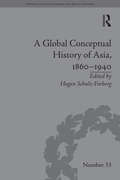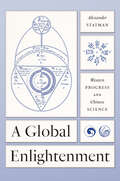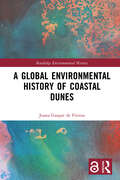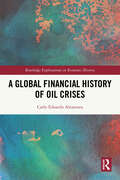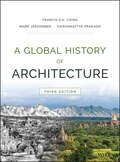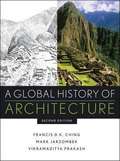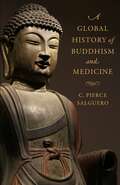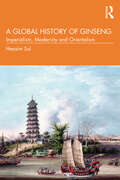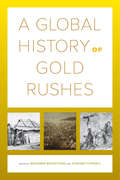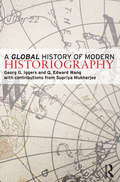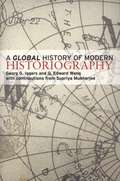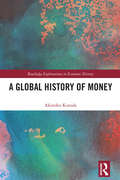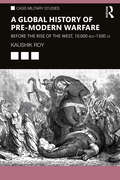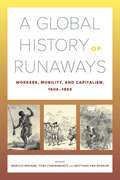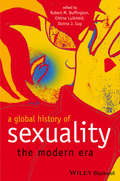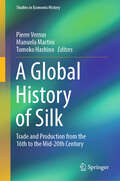- Table View
- List View
A Global Chronology of Conflict: Volume 2, 1500-1774
by Spencer TuckerNow from ABC-CLIO, long regarded as a premier publisher of military history, comes a monumental resource that encapsulates the entire scope of conflict among human societies. Spanning nearly five millennia, from the earliest documented fighting to the present, A Global Chronology of Conflict: From the Ancient World to the Modern Middle East, provides a comprehensive survey of major military events. With coverage that reaches beyond the battles, this work examines the political and diplomatic forces driving world conflicts, revolutions, forced changes of governments, international treaties, and acts of aggression and terrorism.
A Global Chronology of Conflict: Volume 3, 1775-1860
by Spencer TuckerNow from ABC-CLIO, long regarded as a premier publisher of military history, comes a monumental resource that encapsulates the entire scope of conflict among human societies. Spanning nearly five millennia, from the earliest documented fighting to the present, A Global Chronology of Conflict: From the Ancient World to the Modern Middle East , provides a comprehensive survey of major military events. With coverage that reaches beyond the battles, this work examines the political and diplomatic forces driving world conflicts, revolutions, forced changes of governments, international treaties, and acts of aggression and terrorism.Written by acclaimed military historian Spencer C. Tucker, these six chronologically organized volumes offer an accessible, richly detailed timeline of military conflict across human history. The concise entries cover all important events on the battlefield and in the corridors of power, with special features highlighting hundreds of key leaders and weapon systems. From specific data on casualties to coverage of evolving weapons technology to insightful analyses of the social impact of war, A Global Chronology of Conflict is an essential resource for students, researchers, history buffs, and general readers alike.
A Global Chronology of Conflict: Volume 4, 1861-1918
by Spencer TuckerNow from ABC-CLIO, long regarded as a premier publisher of military history, comes a monumental resource that encapsulates the entire scope of conflict among human societies. Spanning nearly five millennia, from the earliest documented fighting to the present, A Global Chronology of Conflict: From the Ancient World to the Modern Middle East, provides a comprehensive survey of major military events. With coverage that reaches beyond the battles, this work examines the political and diplomatic forces driving world conflicts, revolutions, forced changes of governments, international treaties, and acts of aggression and terrorism.
A Global Chronology of Conflict: Volume 5, 1919-1949
by Spencer TuckerThis six-volume reference (1. 5 million words) constitutes a seemingly monumental enterprise for one person, that one person being a meticulous expert who didn't confine himself to a simple chronology but instead expanded the project to encompass plenty of contextual and supplementary material. Tucker is a former army captain and intelligence analyst who served in the Pentagon during the Vietnam War and subsequently taught military history for decades at Texas Christian University and at Virginia Military Institute before retiring in 2003. Undaunted by the task at hand, he presents a year-by-year, event-by-event chronology, having made a set of criteria and guidelines for selection and presentation (these are explained in his preface). The volumes include, also, a total of 376 biographical profiles and 301 key innovations and technologies--weapons that changed history, as well as some 250 detailed descriptions of key battles throughout history, and a couple hundred maps. Each volume includes the comprehensive index.
A Global Chronology of Conflict: Volume 6, 1950-2008
by Spencer TuckerNow from ABC-CLIO, long regarded as a premier publisher of military history, comes a monumental resource that encapsulates the entire scope of conflict among human societies. Spanning nearly five millennia, from the earliest documented fighting to the present, A Global Chronology of Conflict: From the Ancient World to the Modern Middle East provides a comprehensive survey of major military events. With coverage that reaches beyond the battles, this work examines the political and diplomatic forces driving world conflicts, revolutions, forced changes of governments, international treaties, and acts of aggression and terrorism. Written by acclaimed military historian Spencer C. Tucker, these six chronologically organized volumes offer an accessible, richly detailed timeline of military conflict across human history. The concise entries cover all important events on the battlefield and in the corridors of power, with special features highlighting hundreds of key leaders and weapon systems. From specific data on casualties to coverage of evolving weapons technology to insightful analyses of the social impact of war, A Global Chronology of Conflict is an essential resource for students, researchers, history buffs, and general readers alike.
A Global Conceptual History of Asia, 1860–1940 (Perspectives in Economic and Social History #33)
by Hagen Schulz-ForbergContributors to this volume explore the changing concepts of the social and the economic during a period of fundamental change across Asia. They challenge accepted explanations of how Western knowledge spread through Asia and show how versatile Asian intellectuals were in introducing European concepts and in blending them with local traditions.
A Global Encyclopedia of Historical Writing (Garland Reference Library Of The Humanities)
by D. R. WoolfFirst published in 1998. Routledge is an imprint of Taylor & Francis, an informa company.
A Global Enlightenment: Western Progress and Chinese Science (The Life of Ideas)
by Alexander StatmanA revisionist history of the idea of progress reveals an unknown story about European engagement with Chinese science. The Enlightenment gave rise not only to new ideas of progress but consequential debates about them. Did distant times and places have anything to teach the here and now? Voltaire could believe that they did; Hegel was convinced that they did not. Early philosophes praised Chinese philosophy as an enduring model of reason. Later philosophes rejected it as stuck in the past. Seeking to vindicate ancient knowledge, a group of French statesmen and savants began a conversation with the last great scholar of the Jesuit mission to China. Together, they drew from Chinese learning to challenge the emerging concept of Western advancement. A Global Enlightenment traces this overlooked exchange between China and the West to make compelling claims about the history of progress, notions of European exceptionalism, and European engagement with Chinese science. To tell this story, Alexander Statman focuses on a group of thinkers he terms “orphans of the Enlightenment,” intellectuals who embraced many of their contemporaries’ ideals but valued ancient wisdom. They studied astronomical records, gas balloons, electrical machines, yin-yang cosmology, animal magnetism, and Daoist medicine. And their inquiries helped establish a new approach to the global history of science. Rich with new archival research and fascinating anecdotes, A Global Enlightenment deconstructs two common assumptions about the early to late modern period. Though historians have held that the idea of a mysterious and inscrutable East was inherent in Enlightenment progress theory, Statman argues that it was the orphans of the Enlightenment who put it there: by identifying China as a source of ancient wisdom, they turned it into a foil for scientific development. But while historical consensus supposes that non-Western ideas were banished from European thought over the course of the Enlightenment, Statman finds that Europeans became more interested in Chinese science—as a precursor, then as an antithesis, and finally as an alternative to modernity.
A Global Environmental History of Coastal Dunes (Routledge Environmental History)
by Joana Gaspar de FreitasThis book provides a holistic perspective on coastal dunes, highlighting new insights into present-day challenges to show that narratives, along with numbers, graphics, and computer models, have a role to play in climate change science, policymaking, and citizenship awareness.Adopting a cross-disciplinary approach, this book combines fiction, history, and science, to discuss past, present, and future ways of living in coastal areas. Dunes are hybrid environments, a combination of natural elements and human agency; they tell stories of values, traditional wisdom, institutions, empires, technology, vulnerabilities, coastal management, adaptation, andsustainability. Drawing on the past, Joana Gaspar de Freitas unpacks a diverse and fascinating history of dunes, linking knowledge, methods, and approaches from several case studies across the world, including France, Portugal, Brazil, Mozambique, New Zealand, USA, and the UK. The book connects the bio geophysics of global change with the main driver of transformation— human agency—to integrate and address nature-society issues, taking human and nonhuman agents into account. In following the choices, paths, and strategies that created today’s coastal landscapes, the book generates greater awareness and understanding of how to shape coastal futures.This is an engaging, original, and, fundamentally, important book that fills a gap in our knowledge of cities, infrastructure, economies, and cultures built on shorelines. A key read for scholars, researchers, and students in environmental history, environmental science, sustainability, coastal land management, and climate change.
A Global Financial History of Oil Crises (Routledge Explorations in Economic History)
by Carlo Edoardo AltamuraIn this book, Altamura analyses the oil shocks of 1973 and 1979, considering their impact on the world economy and subsequent reactions to the global instability.In terms of actors, the focus is on how international organisations such as the IMF, World Bank and OECD responded to the crisis, as well as the behaviour of commercial banks and central banks and of countries in the Global South. Altamura draws on newly available archival material from private financial institutions to paint a full picture of a rapidly changing world which paved the way for stagflation and interdependency.This monograph will be illuminating reading for economic and financial historians, plus scholars looking at energy history, the Cold War in a global context, the New International Economic Order and the political economy of the 1970s.
A Global History of Architecture
by Vikramaditya Prakash Francis D. Ching Mark M. JarzombekThe gold-standard exploration of architecture's global evolution A Global History of Architecture provides a comprehensive tour through the ages, spinning the globe to present the landmark architectural movements that characterized each time period. Spanning from 3,500 b.c.e. to the present, this unique guide is written by an architectural all-star team who emphasize connections, contrasts and influences, reminding us that history is not linear and that everything was 'modern architecture' in its day. This new third edition has been updated with new drawings from Professor Ching, including maps with more information and color, expanded discussion on contemporary architecture, and in-depth chapter introductions that set the stage for global views. The all-new online enhanced companion site brings history to life, providing a clearer framework through which to interpret and understand architecture through the ages. Unique in its non-Eurocentrism, this book provides a fresh survey of architectural history with a truly global perspective, fulfilling the National Architectural Accrediting Board's requirements for 'non-Western' architecture in history education. Track the history of architecture through a comparative timeline that spans the globe Learn how disparate design styles evolved side-by-side, and which elements migrated where Delve into non-Western architecture with expert insight and an historical perspective Explore further with an online Interactive Resource Center featuring digital learning tools Escalating globalization has expanded our perspective of both history and architecture beyond Europe and the U.S. Today's architects are looking far beyond the traditional boundaries, and history shows us that structures' evolution from shelter to art mirrors the hopes and fears of society along the way. A Global History of Architecture takes you inside history itself to witness the the growth and movements that built our world.
A Global History of Architecture
by Francis D. K. Ching Mark Jarzombek Vikramaditya PrakashPraise for the First Edition "Because of its exceptionally wide perspective, even architectural historians who do not teach general survey courses are likely to enjoy and appreciate it. " -Annali d'architettura "Not only does A Global History of Architecture own the territory (of world architecture), it pulls off this audacious task with panache, intelligence, and-for the most part-grace. " -Journal of the Society of Architectural Historians Revised and updated-the compelling history of the world's great architectural achievements Organized along a global timeline, A Global History of Architecture, Second Edition has been updated and revised throughout to reflect current scholarship. Spanning from 3,500 b. c. e. to the present, this unique guide is written by an all-star team of architectural experts in their fields who emphasize the connections, contrasts, and influences of architectural movements throughout history. The architectural history of the world comes to life through a unified framework for interpreting and understanding architecture, supplemented by rich drawings from the renowned Frank Ching, as well as brilliant photographs. This new Second Edition: Delivers more coverage of non-Western areas, particularly Africa, South Asia, South East Asia, and Pre-Columbian America Is completely re-designed with full-color illustrations throughout Incorporates additional drawings by Professor Ching, including new maps with more information and color Meets the requirements set by the National Architectural Accrediting Board (NAAB) for "non-Western" architecture in history education. Offers new connections to a companion Web site, including Google EarthTM coordinates for ease of finding sites. Architecture and art enthusiasts will find A Global History of Architecture, Second Edition perpetually at their fingertips.
A Global History of Buddhism and Medicine
by C. Pierce SalgueroMedicine, health, and healing have been central to Buddhism since its origins. Long before the global popularity of mindfulness and meditation, Buddhism provided cultures around the world with conceptual tools to understand illness as well as a range of therapies and interventions for care of the sick. Today, Buddhist traditions, healers, and institutions continue to exert a tangible influence on medical care in societies both inside and outside Asia, including in the areas of mental health, biomedicine, and even in responses to the COVID-19 pandemic. However, the global history of the relationship between Buddhism and medicine remains largely untold.This book is a wide-ranging and accessible account of the interplay between Buddhism and medicine over the past two and a half millennia. C. Pierce Salguero traces the intertwining threads linking ideas, practices, and texts from many different times and places. He shows that Buddhism has played a crucial role in cross-cultural medical exchange globally and that Buddhist knowledge formed the nucleus for many types of traditional practices that still thrive today throughout Asia. Although Buddhist medicine has always been embedded in local contexts and differs markedly across cultures, Salguero identifies key patterns that have persisted throughout this long history. This book will be informative and invaluable for scholars, students, and practitioners of both Buddhism and complementary and alternative medicine.
A Global History of Ginseng: Imperialism, Modernity and Orientalism
by Heasim SulSul’s history of the international ginseng trade reveals the cultural aspects of international capitalism and the impact of this single commodity on relations between the East and the West. Ginseng emerged as a major international commodity in the seventeenth century, when the East India Company began trading it westward. Europeans were drawn to the plant’s efficacy as a medicine, but their attempts to transplant it for mass production were unsuccessful. Also, due to a failure of extracting its active ingredients, Western pharmacology disparaged ginseng in the process of modernization. In the meantime, ginseng was discovered on the American continent and became one of the United States’ key exports to Asia and particularly China, but never cultivated a significant domestic market. As such, historicizing the ginseng trade provides a unique perspective on the impact of both culture and economics on international trade. A compelling interdisciplinary history of over five centuries of East–West trade and cultural exchange, this book will be invaluable to students and scholars of transnational history and a fascinating read for anyone interested in the history of international trade.
A Global History of Gold Rushes (California World History Library #25)
by Benjamin Mountford Stephen TuffnellNothing set the world in motion like gold. Between the discovery of California placer gold in 1848 and the rush to Alaska fifty years later, the search for the precious yellow metal accelerated worldwide circulations of people, goods, capital, and technologies. A Global History of Gold Rushes brings together historians of the United States, Africa, Australasia, and the Pacific World to tell the rich story of these nineteenth century gold rushes from a global perspective. Gold was central to the growth of capitalism: it whetted the appetites of empire builders, mobilized the integration of global markets and economies, profoundly affected the environment, and transformed large-scale migration patterns. Together these essays tell the story of fifty years that changed the world.
A Global History of Modern Historiography
by Q. Edward Wang Supriya Mukherjee Georg G IggersSo far histories of historiography have concentrated almost exclusively on the West. This is the first book to offer a history of modern historiography from a global perspective. Tracing the transformation of historical writings over the past two and half centuries, the book portrays the transformation of historical writings under the effect of professionalization, which served as a model not only for Western but also for much of non-Western historical studies. At the same time it critically examines the reactions in post-modern and post-colonial thought to established conceptions of scientific historiography. A main theme of the book is how historians in the non-Western world not only adopted or adapted Western ideas, but also explored different approaches rooted in their own cultures.
A Global History of Modern Historiography
by Q. Edward Wang Supriya Mukherjee Georg G IggersThe first book on historiography to adopt a global and comparative perspective on the topic, A Global History of Modern Historiography looks not just at developments in the West but also at the other great historiographical traditions in Asia, the Middle East, and elsewhere around the world over the course of the past two and a half centuries. This second edition contains fully updated sections on Latin American and African historiography, discussion of the development of global history, environmental history, and feminist and gender history in recent years, and new coverage of Russian historical practices. Beginning in the mid-eighteenth century, the authors analyse historical currents in a changing political, social and cultural context, examining both the adaptation and modification of the Western influence on historiography and how societies outside Europe and America found their own ways in the face of modernization and globalization. Supported by online resources including a selection of excerpts from key historiographical texts, this book offers an up-to-date account of the status of historical writing in the global era and is essential reading for all students of modern historiography.
A Global History of Modern Historiography
by Georg G. Iggers Q. Edward Wang Supriya MukherjeeA critical survey of historical thought and writing since the late eighteenth century from an intercultural, comparative global perspective. A comprehensive overview of historical thought and writing in the modern period. The first history of modern historiography which deals with the interaction of Western and non-Western historical thought. Sets historiography into its social, political and cultural context.
A Global History of Modern Historiography
by Q. Edward Wang Supriya Mukherjee Georg IggersThe first book on historiography to adopt a global and comparative perspective on the topic, A Global History of Modern Historiography looks not just at developments in the West but also at the other great historiographical traditions in Asia, the Middle East, and elsewhere around the world over the course of the past two and a half centuries. This second edition contains fully updated sections on Latin American and African historiography, discussion of the development of global history, environmental history, and feminist and gender history in recent years, and new coverage of Russian historical practices. Beginning in the mid-eighteenth century, the authors analyse historical currents in a changing political, social and cultural context, examining both the adaptation and modification of the Western influence on historiography and how societies outside Europe and America found their own ways in the face of modernization and globalization.Supported by online resources including a selection of excerpts from key historiographical texts, this book offers an up-to-date account of the status of historical writing in the global era and is essential reading for all students of modern historiography.
A Global History of Money (Routledge Explorations in Economic History)
by Akinobu KurodaLooking from the 11th century to the 20th century, Kuroda explores how money was used and how currencies evolved in transactions within local communities and in broader trade networks. The discussion covers Asia, Europe and Africa and highlights an impressive global interconnectedness in the pre-modern era as well as the modern age. Drawing on a remarkable range of primary and secondary sources, Kuroda reveals that cash transactions were not confined to dealings between people occupying different roles in the division of labour (for example shopkeepers and farmers), rather that peasants were in fact great users of cash, even in transactions between themselves. The book presents a new categorization framework for aligning exchange transactions with money usage choices. This fascinating monograph will be of great interest to advanced students and researchers of economic history, financial history, global history and monetary studies.
A Global History of Pre-Modern Warfare: Before the Rise of the West, 10,000 BCE–1500 CE (Cass Military Studies)
by Kaushik RoyThis book examines the military histories of the regions beyond Western Europe in the pre-modern era. Existing works on global military history mainly focus on the western part of Eurasia after 1500 CE. As regards the ancient period, such works concentrate exclusively on Greece and Rome. So, ‘global’ military history is actually the triumphal story of the West from Classical Greece onwards. This volume focuses not only on the eastern part of Eurasia but also on South America, Africa and Australasia and seeks to explain the history and varied trajectories of warfare in non-Western regions in the pre-modern era. Further, it evaluates whether warfare in non-Western regions should be considered primitive or inferior when compared with Western warfare. The book notes that Western Europe became militarily significant only in the early modern era and argues that the military divergence that occurred during the early modern era is not unique – it had also occurred in the Bronze Age, the Classical era and in the medieval period. This was due to the dynamism and innovativeness of non-Western militaries and the interconnectedness that existed in parts of the Eurasian landmass. Further, those polities which were able to construct a balanced military force by synthesising diverse elements were not only able to survive but also became capable of projecting power across continents. This book will be of much interest to students of military history, strategic studies and world history.
A Global History of Runaways: Workers, Mobility, and Capitalism, 1600–1850 (California World History Library #28)
by Marcus Rediker, Titas Chakraborty and Matthias van RossumDuring global capitalism's long ascent from 1600–1850, workers of all kinds—slaves, indentured servants, convicts, domestic workers, soldiers, and sailors—repeatedly ran away from their masters and bosses, with profound effects. A Global History of Runaways, edited by Marcus Rediker, Titas Chakraborty, and Matthias van Rossum, compares and connects runaways in the British, Danish, Dutch, French, Mughal, Portuguese, and American empires. Together these essays show how capitalism required vast numbers of mobile workers who would build the foundations of a new economic order. At the same time, these laborers challenged that order—from the undermining of Danish colonization in the seventeenth century to the igniting of civil war in the United States in the nineteenth.
A Global History of Sexual Science, 1880–1960 (California World History Library #26)
by Veronika Fuechtner, Douglas E. Haynes, and Ryan M. JonesStarting in the late nineteenth century, scholars and activists all over the world suddenly began to insist that understandings of sex be based on science. As Japanese and Indian sexologists influenced their German, British, and American counterparts and vice versa, sexuality, modernity, and imaginings of exotified "Others" became intimately linked. The first anthology to provide a worldwide perspective on the birth and development of the field, A Global History of Sexual Science contends that actors outside of Europe—in Asia, Latin America, and Africa—became important interlocutors in debates on prostitution, birth control, and transvestism. Ideas circulated through intellectual exchange, travel, and internationally produced and disseminated publications. Twenty scholars tackle specific issues, including the female orgasm and the criminalization of male homosexuality, to demonstrate how concepts and ideas introduced by sexual scientists gained currency throughout the modern world.
A Global History of Sexuality: The Modern Era
by Donna J. Guy Robert M. Buffington Eithne LuibhéidA Global History of Sexuality provides a provocative, wide-ranging introduction to the history of sexuality from the late eighteenth century to the present day. Explores what sexuality has meant in the everyday lives of individuals over the last 200 years Organized around four major themes: the formation of sexual identity, the regulation of sexuality by societal norms, the regulation of sexuality by institutions, and the intersection of sexuality with globalization Examines the topic from a comparative, global perspective, with well-chosen case studies to illuminate the broader themes Includes interdisciplinary contributions from prominent historians, sociologists, anthropologists, and sexuality studies scholars Introduces important theoretical concepts in a clear, accessible way
A Global History of Silk: Trade and Production from the 16th to the Mid-20th Century (Studies in Economic History)
by Tomoko Hashino Manuela Martini Pierre VernusThis book explores the global development of the production and trade of silk and related industries from a historical perspective. From the sixteenth to the twentieth century, it takes long-term movements and global dynamics into account. Covering a wide geographical area, including East-Asia, Northern and Southern Europe, and North-America, the respective contributions examine economic activities related to silk production, silk processing, trading and consumption of silk and silk fabrics, while also highlighting diverse paths of industrialization and economic development. The book is divided into three parts, the first of which features contributions on silk markets and trade, covering topics such as auction sales and Sino-European trade. The second part addresses issues of work organization, institutional developments and the gendered division of labour, discussing topics such as systems of home-based and factory production and the organization of quality control. In turn, the third part highlights technological innovations and knowledge transfer. This book appeals to scholars and students of economic history who are interested in a better understanding of the key features and patterns in the development of the silk industry and trade and, more widely, in the global economic history of the early modern and modern periods.


